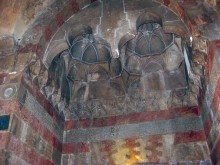Jerusalem’s religious symbolism in Islam prompted large groups of worshippers and dedicated Muslims to make it their destination. Sufism started with the early stages of Islam and the manner in which Prophet Muhammad and his followers conducted their lives.
Through the history Sufis built Mosques and private homes were centers for Sufism and its patrons, and later on they have built Sufi institutions. Sufism flourished in Jerusalem in the Mamluk and ottoman eras. One type of the Sufi buildings is “Khanqa”. Khanqa is a Persian word meaning home and was used in Mamluk literature to describe a mosque and a Sufi home, possibly with a school or dormitory attached to it. We introduce to you through this article one of the best known Khanqa in the Old City of Jerusalem:
Khanqa al-Dawadariyya (1295 AD / 695 H)
The al-Dawadariyya is located directly south of the Salamiyya School on Bab al-Atm Street, and adjacent to al-Aqsa Mosque from the north. This seminary obtained its original name (al-Dawadariyya) from its founder, Amir Alam al-Din Abu Musa al-Dawadar. He was known for his compassion towards Sufis and sponsorship of science and scientists. His home was believed to resemble a mosque.
The inscription above the entrance describes the motives for the establishment of the seminary. It indicates that the Khanqa was established in an effort to please Allah (God), and to provide shelter to 30 members of Arab and non-Arab members of the Sufi order. Any Sufi arriving at the seminary would be hosted for a period of ten days. To guarantee that the Khanqa would continue to cover its expenses, the founder provided it with generous religious endowment.
Al-Dawadariyya is original in its design and in the beauty of its architectural details. Its only entrance, opening to the west, is a unique architectural marvel in Jerusalem architecture. It was built from interlocking red and grey stones until the beginning of the vault covering the recessed entrance. Above the entrance opening is a stone lintel, followed directly by a relieving arch composed of connected stones. Above that, the text referred to above is inscribed with three rows of beautifully formed stalactite stone elements.
Ahead of the entrance cover, towards the street, are two triple arches with pointed openings, preceded by a pointed arch formed from connected colorful stones.
The entrance leads directly to an open rectangular courtyard paved with large stone tiles. The courtyard is surrounded from the north and south by small sanctums where the Sufis lived. On the south side is a large rectangular hall which was used for teaching the Quran and Hadith, and also for meetings by the Sufis residing in this building.
For further readings about Khanqas and other historical sites in Jerusalem, please visit: EnjoyJerusalem.com


